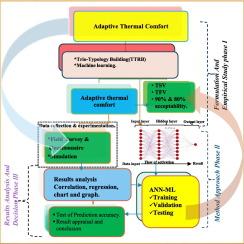Application of ANN-ML in evaluating indoor thermal comfort of trio-typology residential building
IF 6.9
2区 工程技术
Q1 ENVIRONMENTAL SCIENCES
引用次数: 0
Abstract
Rapid urbanization in regions like Abuja, Nigeria, poses significant challenges in achieving sustainable indoor thermal comfort, particularly when integrating traditional building techniques. This study evaluates adaptive thermal comfort in trio-typology residential buildings (TTRB), namely; modern (BDG1), traditional (BDG2), and compressed earth (BDG3), using an artificial neural network machine learning (ANN-ML) model. Environmental parameters were monitored over seven days during the rainy and dry seasons, alongside 230 occupant surveys capturing thermal sensation (TSV) and preference (TPV) votes. A simulation of a three-bedroom model was conducted using Design Builder software to assess natural ventilation (NV) performance. The ANN-ML model predicted TSV and thermal comfort (Tc) at 70 % training, 15 % validation, and 15 % testing under controlled conditions.
Results revealed rainy season temperatures ranged from 23.6 °C to 29.3 °C, while dry season temperatures spanned 25.0 °C to 35.3 °C. Thermal comfort zones were established at 27.4 °C (rainy season) and 20.54 °C (dry season). During the rainy season, 47.3 % of occupants reported feeling “slightly cool,” while 33.6 % felt “slightly warm.” in the dry season, 41.8 % perceived morning conditions as “cool,” with 63.6 % preferring warmer temperatures. The ANN-ML analysis demonstrated high accuracy in predicting occupant thermal comfort in NV buildings, confirming its reliability for such assessments. The findings highlight the potential of traditional building techniques to significantly enhance indoor thermal comfort. This study underscores the importance of integrating passive design strategies and machine learning models to optimize sustainable building performance in tropical climates.

ANN-ML在三型态住宅室内热舒适性评价中的应用
尼日利亚阿布贾等地区的快速城市化对实现可持续的室内热舒适提出了重大挑战,特别是在整合传统建筑技术时。本研究对三类型住宅(TTRB)的适应性热舒适进行评价,即;现代(BDG1),传统(BDG2)和压缩土(BDG3),使用人工神经网络机器学习(ANN-ML)模型。在雨季和旱季对环境参数进行了为期7天的监测,同时对230名居住者进行了热感觉(TSV)和偏好(TPV)投票。利用Design Builder软件对一个三卧室模型进行了模拟,以评估自然通风(NV)的性能。ANN-ML模型在70%的训练、15%的验证和15%的受控条件下测试时预测TSV和热舒适(Tc)。
本文章由计算机程序翻译,如有差异,请以英文原文为准。
求助全文
约1分钟内获得全文
求助全文
来源期刊

Urban Climate
Social Sciences-Urban Studies
CiteScore
9.70
自引率
9.40%
发文量
286
期刊介绍:
Urban Climate serves the scientific and decision making communities with the publication of research on theory, science and applications relevant to understanding urban climatic conditions and change in relation to their geography and to demographic, socioeconomic, institutional, technological and environmental dynamics and global change. Targeted towards both disciplinary and interdisciplinary audiences, this journal publishes original research papers, comprehensive review articles, book reviews, and short communications on topics including, but not limited to, the following:
Urban meteorology and climate[...]
Urban environmental pollution[...]
Adaptation to global change[...]
Urban economic and social issues[...]
Research Approaches[...]
 求助内容:
求助内容: 应助结果提醒方式:
应助结果提醒方式:


